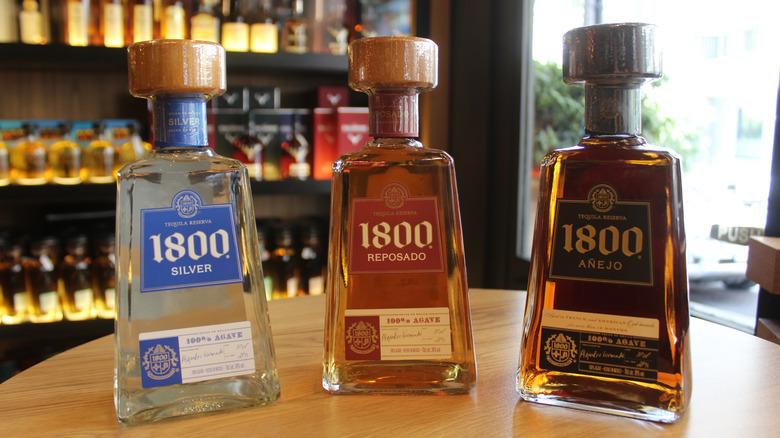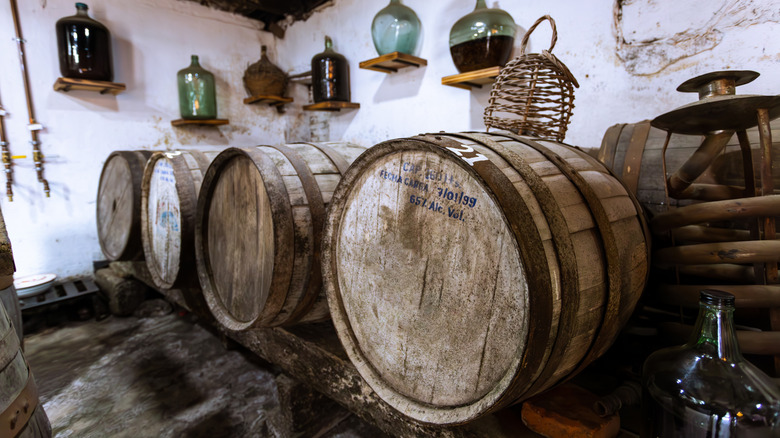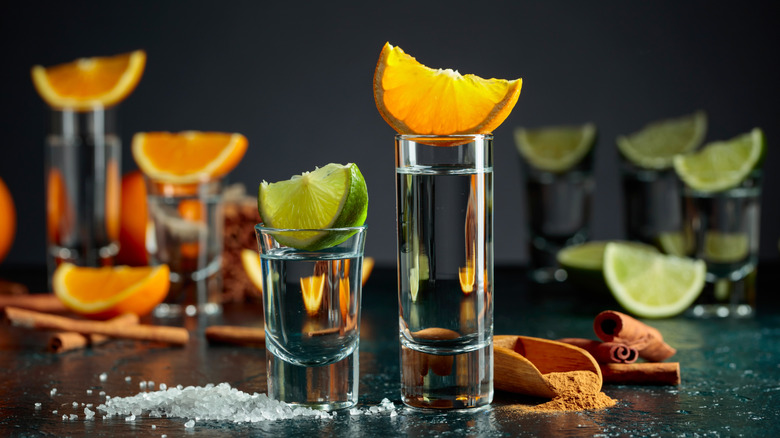How Do Blanco, Reposado, And Añejo Tequila Differ?
When a bartender asks you what kind of tequila you want, you might hesitate. A scan of the selection will likely reveal several varieties, including reposado and añejo. You'll also see blanco, though this type is often labeled silver or plata. If you're wondering whether these tequilas are really that different, the answer is a resounding yes.
Besides having different colors, these three major types go through different aging processes, despite all of them using agave. Dark brown añejo has a more rounded, smooth, vanilla flavor with notes of baking spices and dried fruits, whereas crystal clear blanco is strong, sharp, and clean with flavors reminiscent of citrus and pepper. Reposado is golden amber in color and falls somewhere in the middle – it has subtle notes of wood and caramel like a less-rich añejo but also still has a citrusy bite. You may also spot joven, oro, extra-añejo, and cristalino tequilas on some shelves, leading you to wonder how one specific spirit can have so many wildly different varieties.
Blanco, reposado, and añejo tequilas are made differently
Tequila can only legally be made in Mexico because of Denomination of Origin laws, specifically in the state of Jalisco and only some areas of Guanajuato, Michoacán, Nayarit, and Tamaulipas. It also must be made with at least 51% blue Weber agave, though most tequilas of quality specify that they use 100%. They are also all fermented and at least twice distilled.
These different varieties get their unique traits because of how long and how they're aged, not because of different ingredients. Blanco is aged the least, with some varieties not being aged at all and the oldest being aged for two months at most. Reposado, on the other hand, is always aged and sits in steel or wood barrels for up to one year and no less than two months. Añejo is the well-matured grandfather of the others, aged for between one and three years. Añejos are always aged in oak, and the barrels cannot be larger than 600 liters to ensure enough of the wood's qualities are imparted into the spirit.
The difference between añejo and extra añejo tequila is the aging requirement — the latter has a three-year minimum. For a very unique variety, you can look into cristalino tequila, which differs from tequila blanco because it's aged in oak but then filtered to look clear.
Pick the right tequila for the occasion
While you can relax and sip any tequila, when it comes to mixing and pairing, each variety has its own strong suit. Blanco is the go-to for a wide variety of cocktails and for taking shots. Its strong, unadulterated agave taste can be harsh for those not experienced with tequila, and the lack of aging requirements means blanco tequila can be more affordable than the other varieties. However, a high-quality blanco is still best enjoyed sipped plain or alongside a wedge of citrus.
Reposado is balanced, sweet, and fragrant in a way that lends itself well to both citrusy and more spirit-forward drinks – it's as good in a paloma as it is in a Manhattan. When you want to just kick back and sip slowly with or without ice, that's when reposado really shines.
As for añejo, fans of dark spirits will really enjoy this tequila straight, though it is also great in simple, boozy cocktails that usually feature whiskey or bourbon — like an old fashioned. Sip on extra añejo for even deeper vanilla and spice notes. With all this information in mind, you'll be able to give a confident answer the next time a bartender asks you to pick your poison.


